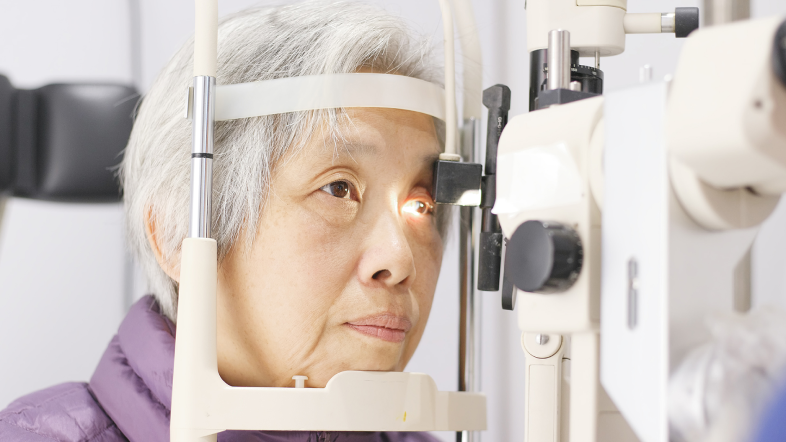Development of dry eyes disease in people with diabetes
Dry eye disease (DED), or keratoconjunctivitis sicca, is common in diabetic patients. Studies show that up to 54% of people with diabetes experience dry eye symptoms.1 While the exact relationship between these two conditions is not yet fully understood, several factors may contribute to the development of dry eyes in people with diabetes.
Diabetes
Diabetes is a long‐lasting condition that impacts how your body handles blood sugar (glucose). When you eat, your body breaks down the food into glucose, which then enters your bloodstream. Your pancreas produces a hormone called insulin, which helps your cells use glucose for energy. More than 530 million people had diabetes globally in 2021, of which more than 90 million in Southeast Asia. It is projected that this number will increase to 783 million by 2045.2
Three primary kinds of diabetes exist: type 1, type 2, and gestational diabetes:

Left untreated, diabetes can lead to various health problems, such as kidney damage, eye problems, and cardiovascular disease.5-7 Diabetes is the leading cause of kidney failure, lower‐limb amputations, and adult blindness.2 The consequences on the eyes include cataracts, glaucoma, and retinopathy. Healthcare providers play a crucial role in helping the patients manage their blood sugar levels and maintain a healthy lifestyle to reduce the risk of complications.
Why people with diabetes are more prone to developing DED
Diabetes may cause dry eyes in several ways, including affecting the function of the lacrimal gland, oil glands in the eyelids (Meibomian glands), and optic nerves. Inadequate insulin levels can lead to decreased tear production because insulin is crucial to the proper functioning of the lacrimal gland. Meanwhile, high blood glucose can damage nerves and cause inflammation that impairs tear production and the flow of oils from Meibomian glands that keep tears from evaporating. Diabetes may also induce a decrease in the number of conjunctival goblet cells. It reduces mucin production and alters the hydrophilic nature of the ocular surface, leading to tear film instability. These effects can lead to both decreased quantity and quality of tears, causing eye dryness and discomfort.8
Complications of diabetes‐related DED
Diabetic patients with dry eyes may experience similar symptoms to those without diabetes, including gritty feelings, soreness, redness, blurry vision, and excessive tears, which may happen when the eyes try to compensate for chronic dryness by overproducing tears. More severe cases may lead to complications such as corneal lesions, conjunctivitis, and inflammation. Gritty sensation is the dominant symptom in patients with diabetes‐related DED.1,8
The severity of dry eye symptoms is higher in diabetic patients with poor glycemic control. Patients with longer diabetes duration report fewer symptoms, which may be caused by decreased corneal sensitivity due to diabetic peripheral corneal neuropathy.9 But those without symptoms are less likely to seek care.8
Tips to prevent and relieve diabetes‐related DED
Early detection of diabetes‐related DED and treatment are essential to prevent complications. Typically, the tips to alleviate symptoms for diabetic and non‐diabetic dry eyes are the same, including limiting use of electronic devices, increasing humidity in the air, and using artificial tears. Besides, diabetic patients should regularly examine the ocular surface and tear function and seek for timely advice from their doctor about their eye condition.8

The essential way to prevent diabetes‐related DED is to control your blood sugar levels. Below are some tips:10, 11

- Manaviat, M. R.; Rashidi, M.; Afkhami-Ardekani, M.; Shoja, M. R. Prevalence of Dry Eye Syndrome and Diabetic Retinopathy in Type 2 Diabetic Patients. BMC Ophthalmol. 2008;8(1):10.
- ATLAS, IDF Diabetes. Diabetes around the world in 2021. International Diabetes Federation, 2021.
- CDC. What is Diabetes? Centers for Disease Control and Prevention. https://www.cdc.gov/diabetes/basics/diabetes.html (accessed 2023-02-17).
- Xie, J.; Wang, M.; Long, Z.; Ning, H.; Li, J.; Cao, Y.; Liao, Y.; Liu, G.; Wang, F.; Pan, A. Global Burden of Type 2 Diabetes in Adolescents and Young Adults, 1990-2019: Systematic Analysis of the Global Burden of Disease Study 2019. BMJ 2022, e072385.
- Diabetic nephropathy (kidney disease) - Symptoms and causes. Mayo Clinic. https://www.mayoclinic.org/diseases-conditions/diabetic-nephropathy/symptoms-causes/syc20354556 (accessed 2023-02-17).
- CDC. Diabetes and Vision Loss. Centers for Disease Control and Prevention. https://www.cdc.gov/diabetes/managing/diabetes-vision-loss.html (accessed 2023-02-17).
- CDC. Diabetes and Your Heart. Centers for Disease Control and Prevention. https://www.cdc.gov/diabetes/library/features/diabetes-and-heart.html (accessed 2023-02-17).
- Zhang, X.; Zhao, L.; Deng, S.; Sun, X.; Wang, N. Dry Eye Syndrome in Patients with Diabetes Mellitus: Prevalence, Etiology, and Clinical Characteristics. J. Ophthalmol. 2016;2016:8201053.
- Bunya, V.; Fuerst, N.; Langelier, N.; Massaro-Giordano, M.; Pistilli, M.; Burns, C.; Cardillo, S.; Stasi, K. Tear Osmolarity and Dry Eye Symptoms in Diabetics. Clin. Ophthalmol. 2014:8:507-15.
- 10 tips for healthy eating with diabetes. Diabetes UK. https://www.diabetes.org.uk/guide-todiabetes/enjoy-food/eating-with-diabetes/10-ways-to-eat-well-with-diabetes (accessed 2023-02-17).
- Diabetes care: 10 ways to avoid complications. Mayo Clinic. https://www.mayoclinic.org/diseases-conditions/diabetes/in-depth/diabetes-management/art20045803 (accessed 2023-02-17).
Five‐item Dry Eye Questionnaire (DEQ-5).
관련 게시물
Five‐item Dry Eye Questionnaire (DEQ-5).
Five‐item Dry Eye Questionnaire (DEQ-5).









